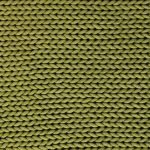If you want durable, stretchy, and moisture-wicking fabric, polyamide is your best bet—it’s strong, wrinkle-resistant, and lasts longer. Viscose feels softer and more breathable, with a natural drape, but it wears out faster and needs delicate care. Polyamide’s made from synthetic fibers, while viscose comes from natural cellulose, so their environmental impacts differ. Understanding these key contrasts will help you pick the fabric that fits your style and needs perfectly.
Table of Contents
Key Takeaways
- Polyamide is a strong, durable synthetic fiber, while viscose is a soft, breathable semi-synthetic fiber made from natural cellulose.
- Polyamide resists wear and moisture better, ideal for activewear; viscose offers a silky feel and drapes well for dressier garments.
- Viscose biodegrades faster and has a lower carbon footprint, whereas polyamide takes longer to decompose and relies on fossil fuels.
- Polyamide requires less maintenance and lasts longer; viscose is delicate, often needing hand washing and careful drying.
- Polyamide is costlier initially but more cost-effective long-term; viscose is cheaper upfront but may need frequent replacement.
Origin and Production Processes
Although both polyamide and viscose serve as popular textile materials, their origins and production processes differ markedly.
When you look at polyamide, you’re dealing with a synthetic fiber made from petrochemicals. It involves a chemical reaction called polymerization, where monomers join to form long polymer chains. This process happens in factories using controlled conditions to produce fibers like nylon.
On the other hand, viscose is a semi-synthetic fiber derived from natural cellulose, often sourced from wood pulp. To make viscose, you first treat the cellulose with chemicals to create a viscous solution, which gets spun into fibers.
Physical and Aesthetic Properties
When you compare polyamide and viscose, you’ll notice they offer distinct physical and aesthetic qualities that suit different needs.
Polyamide, a synthetic fiber, is strong, lightweight, and has a smooth, slightly shiny finish that gives fabrics a sleek, modern look. It resists wrinkles and holds shape well, making it ideal for activewear or garments that need durability.
Viscose, on the other hand, is a semi-synthetic fiber derived from cellulose. It has a soft, silky texture and a natural sheen that mimics silk, lending a luxurious, flowing drape to fabrics.
You’ll find viscose fabrics more breathable and with a matte to subtle shine appearance, perfect for elegant, comfortable clothing.
Each fiber’s characteristics influence the style and function of your garments.
Comfort and Wearability
Understanding the physical and aesthetic qualities of polyamide and viscose helps you appreciate how they feel during wear.
When you choose polyamide, expect a lightweight, smooth fabric that stretches comfortably, making it ideal for activewear or fitted garments. It wicks moisture well, keeping you dry during movement.
Viscose, on the other hand, feels soft and breathable, closely mimicking natural fibers like cotton. You’ll find it drapes beautifully and feels cool against your skin, perfect for casual or dressy outfits in warmer weather.
However, viscose may feel less stretchy and can cling when damp, which might affect comfort during intense activity.
Ultimately, your choice depends on whether you prioritize moisture management and stretch or softness and breathability for everyday wear.
Durability and Maintenance
When it comes to durability, you’ll notice polyamide generally lasts longer and resists wear better than viscose.
You’ll also want to reflect on how each fabric needs care, since their maintenance routines differ.
Understanding these factors helps you choose the right material for your lifestyle.
Longevity Comparison
Although both polyamide and viscose offer unique benefits, polyamide generally outperforms viscose regarding durability and ease of maintenance.
When you choose polyamide, you’re opting for a fabric that resists wear and tear better, so your clothing or items last longer.
Viscose, while soft and breathable, tends to weaken faster, especially with frequent washing or exposure to moisture.
You’ll notice polyamide holds its shape and color over time, reducing the need for replacement.
On the other hand, viscose may pill or lose its smooth texture quicker, which can shorten its lifespan.
Care Requirements
Because polyamide and viscose differ markedly in their durability, their care requirements also vary.
When you care for polyamide, you can usually machine wash it on a gentle cycle with cold water, since it resists shrinking and holds shape well. Avoid high heat during drying; air drying or low heat in the dryer works best. You don’t have to worry much about wrinkles, so ironing is rarely needed.
Viscose, on the other hand, demands more delicate handling. You should hand wash it or use a gentle machine cycle with cold water to prevent weakening fibers. Avoid wringing it out, as this can cause damage. Air drying flat helps maintain its shape.
Iron viscose on a low heat setting while damp to avoid scorching. By following these tailored care steps, you’ll keep both fabrics looking their best longer.
Resistance to Wear
Since you rely on your clothes to withstand daily wear, understanding the durability of polyamide and viscose is key.
Polyamide, a synthetic fiber, offers excellent resistance to abrasion and stretching, making it ideal for activewear and long-lasting garments. Viscose, a semi-synthetic fiber, tends to be more delicate and can wear out faster, especially when exposed to moisture or friction.
When considering resistance to wear, keep these points in mind:
- Polyamide resists pilling and maintains shape after repeated use.
- Viscose may weaken with frequent washing and can develop signs of wear more quickly.
- Both require proper care, but polyamide generally demands less maintenance to stay durable.
Choosing polyamide means you’ll enjoy longer-lasting garments, while viscose needs gentler handling to preserve its look.
Environmental Impact and Sustainability
When choosing between polyamide and viscose, you should consider their production carbon footprints.
You’ll also want to think about how each fabric breaks down since biodegradability affects long-term environmental impact.
Understanding these factors helps you make a more sustainable choice.
Production Carbon Footprint
Although both polyamide and viscose serve as popular textile choices, their production carbon footprints differ markedly, affecting their overall environmental impact.
When you consider their manufacturing processes, you’ll notice how energy use and raw materials play a big role in carbon emissions.
Polyamide, made from fossil fuels, requires more energy, resulting in higher CO2 output. Viscose, derived from wood pulp, involves chemical treatments but generally has a lower carbon footprint.
Here’s what you should keep in mind:
- Polyamide production relies heavily on petroleum, increasing greenhouse gas emissions.
- Viscose involves intensive water and chemical use, but renewable raw materials help reduce carbon impact.
- Advances in sustainable viscose production can further lower its carbon footprint compared to traditional polyamide.
Biodegradability Comparison
Because you care about the environment, understanding the biodegradability of polyamide and viscose is essential.
Viscose, derived from natural cellulose, breaks down much faster when exposed to microbes, usually biodegrading within a few months to a couple of years under proper conditions. This means it has a smaller long-term impact on landfills and ecosystems.
Polyamide, a synthetic polymer, takes considerably longer to decompose—often decades—because it’s petroleum-based and resistant to microbial activity. This slow breakdown contributes to persistent environmental pollution, especially microplastic contamination.
If you want to minimize your ecological footprint, choosing viscose over polyamide can help reduce waste accumulation. However, keep in mind that viscose production has its own environmental challenges, so looking for sustainably sourced viscose is key to maximizing its biodegradability benefits.
Common Uses in Fashion and Textiles
Both polyamide and viscose play significant roles in fashion and textiles, each bringing unique qualities to the materials you wear every day.
Polyamide, known for its durability and elasticity, is often used where strength and stretch are essential. Viscose, on the other hand, offers breathability and a silky feel, making it ideal for comfortable, stylish garments.
You’ll find polyamide in items like:
- Activewear and swimwear, where moisture-wicking and flexibility matter.
- Lingerie and hosiery, benefiting from its smooth texture and resilience.
- Outerwear linings, adding strength without bulk.
Viscose commonly appears in:
- Dresses and blouses, providing a soft drape and sheen.
- Casual shirts, enhancing comfort and breathability.
- Scarves and linings, where its lightweight feel shines.
Cost Comparison and Value for Money
When choosing between polyamide and viscose for your wardrobe, cost and value for money often play a big role in the decision. Polyamide generally costs more upfront but offers greater durability, which can save you money over time. Viscose tends to be cheaper but may wear out faster, leading to more frequent replacements.
| Factor | Polyamide |
|---|---|
| Initial Cost | Higher |
| Durability | Very Durable |
| Maintenance | Low |
| Longevity | Long-lasting |
| Value for Money | High if long-term |
Polyamide is a smart investment if you want long-lasting pieces, while viscose suits those on a tight budget but willing to replace items more often.
Tips for Choosing Between Polyamide and Viscose
How do you decide between polyamide and viscose for your wardrobe? Start by considering the end use and care requirements.
Polyamide suits activewear and items needing durability, while viscose works well for breathable, soft garments.
Next, think about comfort and appearance—viscose offers a natural feel and drapes beautifully; polyamide feels smooth and resists wrinkles.
Consider comfort and style—viscose feels natural and flows beautifully; polyamide is smooth and wrinkle-resistant.
Finally, factor in maintenance and longevity.
- Choose polyamide if you want easy-care, wrinkle-resistant fabrics that last.
- Opt for viscose when softness and breathability are your top priorities.
- Consider your lifestyle: active or casual wear might lean toward polyamide, while dressier options often favor viscose.
Frequently Asked Questions
Can Polyamide and Viscose Be Blended Together in Fabrics?
You can blend polyamide and viscose in fabrics to combine strength and softness. This mix enhances durability while keeping comfort, making your garments more versatile and long-lasting without sacrificing feel or performance.
How Do Polyamide and Viscose React to Dyeing Processes?
Dyeing polyamide and viscose is like painting on different canvases; you’ll find polyamide absorbs dyes vividly and quickly, while viscose soaks them up softly, giving you vibrant yet delicate colors to play with effortlessly.
Are Polyamide and Viscose Suitable for Allergy-Sensitive Skin?
If you have allergy-sensitive skin, you might find viscose gentler because it’s natural and breathable. Polyamide can sometimes irritate due to synthetic fibers, but reactions vary, so always test fabrics before wearing them extensively.
What Are the Fire Resistance Properties of Polyamide Vs Viscose?
You’ll find polyamide is more fire-resistant and melts rather than ignites quickly, while viscose ignites easily and burns fast. So, polyamide offers better protection if you’re concerned about fire safety in fabrics.
Can Polyamide and Viscose Fabrics Be Recycled Effectively?
You’ll find that about 87% of synthetic fabrics like polyamide can be recycled effectively, while viscose recycling is trickier due to its semi-synthetic nature. Still, both require specialized processes to recycle properly and reduce waste.
- Can You Iron Nonwoven Fabric? A Safety Guide - July 11, 2025
- Exploring the Strength and Durability of Nonwoven Fabrics - July 11, 2025
- The Role of Nonwoven Geotextiles in Soil Stabilization - July 11, 2025







